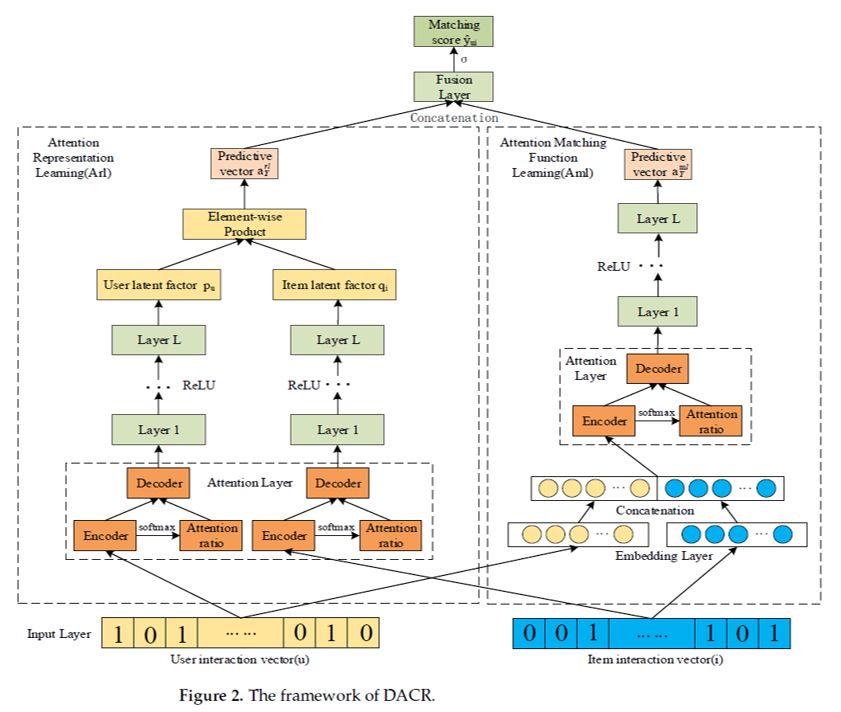User Free Models
Based on the following lectures
(1) “Recommendation System Design (2024-1)” by Prof. Ha Myung Park, Dept. of Artificial Intelligence. College of SW, Kookmin Univ.
(2) "Recommender System (2024-2)" by Prof. Hyun Sil Moon, Dept. of Data Science, The Grad. School, Kookmin Univ.
SLIM
- 문제 의식: 효율성과 정확성의 Trade-off
- 이웃 기반 협업 필터링(Neighborhood-based Collaborative Filtering): 유사도 기반 휴리스틱 함수를 통해 예측하므로 계산 효율성은 높지만 아이템 간 관계 학습이 불가하여 추천 정확도가 낮음
- 잠재요인 모형(Latent Factor Model): 사용자, 아이템 간 관계 학습을 수반하므로 추천 정확도는 높지만 계산 비용이 발생하여 실시간 추천에 부적합
SLIM(SparseLInearMethods): 아이템 간 유사도를 선형 회귀계수 행렬로 학습하고 이를 기반으로 예측을 수행하는 선형 회귀 모형- Ning, X., & Karypis, G.
(2011, December).
Slim: Sparse linear methods for top-n recommender systems.
In 2011 IEEE 11th international conference on data mining (pp. 497-506).
IEEE.
- Ning, X., & Karypis, G.
Notation
- $u=1,2,\cdots,M$: user idx
- $i=1,2,\cdots,N$: item idx
- $\mathbf{Y} \in \mathbb{R}^{M \times N}$: user-item interaction matrix
- $\mathbf{W} \in \mathbb{R}^{N \times N}$: sparse aggregation coefficient matrix
- $\hat{y}_{u,i}$: interaction probability of user $u$ and item $i$
How to Modeling
-
Linear Regression:
\[\begin{aligned} \hat{y}_{u,i} &= \mathbf{W}_{i} \cdot \mathbf{Y}_{u*}\\ &= \sum_{j \in \mathcal{R}_{u}^{+} \setminus \{i\}}{w_{i,j} \cdot y_{u,j}} \end{aligned}\] -
Objective Function:
\[\begin{gathered} \hat{\mathbf{W}} = \text{arg} \min{\frac{1}{2} \Vert \mathbf{Y} - \mathbf{Y}\mathbf{W}\Vert_{F}^{2} + \frac{\beta}{2} \Vert \mathbf{W} \Vert_{F}^{2} + \lambda \Vert \mathbf{W} \Vert_{1}}\\ \text{subject to} \quad \begin{aligned} \mathbf{W} &\ge 0\\ \text{diag}(\mathbf{W})&=0 \end{aligned} \end{gathered}\]- \(\Vert \mathbf{Y} - \mathbf{Y}\mathbf{W}\Vert_{F}^{2}\): Reconstruction Loss
- \(\Vert \mathbf{W} \Vert_{F}^{2}\): L2 Norm Regulation to Prevent Overfitting
- \(\Vert \mathbf{W} \Vert_{1}\): L1 Norm Regulation to Induce Sparsity
FISM
- 문제 의식:
SLIM의 사용자 선호 구성 방식SLIM은 아이템 간 유사도를 휴리스틱 함수가 아니라 학습을 통해 도출한다는 점에서 아이템 기반 협업 필터링의 정확도 문제를 개선함- 하지만 사용자의 타깃 아이템에 대한 선호 구성 시 히스토리를 구성하는 아이템들이 서로 독립적으로 기여한다고 가정함
- 이 독립성 가정은 사용자 선호가 과거 경험의 단순 집계로 환원될 수 있다는 잘못된 전제에 기반함
- 즉, 사용자 선호가 히스토리 아이템들의 집합적 구성과 그 내부의 상호작용 구조에 의해 형성된다는 점을 간과함
FISM(FactoredItemSimilarityModels): 사용자 선호를 히스토리 아이템들의 집합적 평균으로 구성하는 아이템 기반 협업 필터링 모형- Kabbur, S., Ning, X., & Karypis, G.
(2013, August).
Fism: factored item similarity models for top-n recommender systems.
In Proceedings of the 19th ACM SIGKDD international conference on Knowledge discovery and data mining (pp. 659-667).
- Kabbur, S., Ning, X., & Karypis, G.
Notation
- $u=1,2,\cdots,M$: user idx
- $i=1,2,\cdots,N$: target item idx
- $j=1,2,\cdots,N$: history item idx
- $\overrightarrow{\mathbf{p}}_{i} \in \mathbb{R}^{K}$: target item id embedding vector
- $\overrightarrow{\mathbf{q}}_{j} \in \mathbb{R}^{K}$: history item id embedding vector
How to Modeling
-
ID Embedding:
\[\begin{aligned} \overrightarrow{\mathbf{p}}_{i} &= \text{Emb}(j)\\ \overrightarrow{\mathbf{q}}_{j} &= \text{Emb}(i) \end{aligned}\] -
History Item Aggregation:
\[\begin{aligned} \overrightarrow{\mathbf{u}}_{u} &= \frac{1}{\vert \mathcal{R}_{u}^{+} \setminus \{i\} \vert^{\beta}}\sum_{j \in \mathcal{R}_{u}^{+} \setminus \{i\}}{\overrightarrow{\mathbf{q}}_{j}} \end{aligned}\]- $0 < \beta \le 1$
-
Predict interaction probability of user $u$ and item $i$:
\[\begin{aligned} \hat{y}_{u,i} &= \overrightarrow{\mathbf{u}}_{u} \cdot \overrightarrow{\mathbf{p}}_{i} \end{aligned}\]
NAIS
- 문제 의식:
FISM의 히스토리 아이템 집계 방식FISM은 사용자 선호 표현 시 히스토리 아이템 간 기여도 차이를 간과하여 히스토리 아이템들을 단순 평균함
NAIS(NeuralAttentiveItemSimilarity Model): 사용자 선호를 히스토리 아이템으로써 구성하되, 개별 아이템의 기여도에 따라 가중 평균하는 아이템 기반 협업 필터링 모형- He, X., He, Z., Song, J., Liu, Z., Jiang, Y. G., & Chua, T. S.
(2018).
NAIS: Neural attentive item similarity model for recommendation.
IEEE Transactions on Knowledge and Data Engineering, 30(12), 2354-2366.
- He, X., He, Z., Song, J., Liu, Z., Jiang, Y. G., & Chua, T. S.
Notation
- $u=1,2,\cdots,M$: user idx
- $i=1,2,\cdots,N$: target item idx
- $j=1,2,\cdots,N$: history item idx
- $\overrightarrow{\mathbf{p}}_{i} \in \mathbb{R}^{K}$: target item id embedding vector
- $\overrightarrow{\mathbf{q}}_{j} \in \mathbb{R}^{K}$: history item id embedding vector
How to Modeling
-
ID Embedding:
\[\begin{aligned} \overrightarrow{\mathbf{p}}_{i} &= \text{Emb}(i)\\ \overrightarrow{\mathbf{q}}_{j} &= \text{Emb}(j) \end{aligned}\] -
History Item Aggregation:
\[\begin{aligned} \overrightarrow{\mathbf{u}}_{u} &= \text{ATTN}(\overrightarrow{\mathbf{p}}_{i}, \mathbf{Q}[\forall j \in \mathcal{R}_{u}^{+} \setminus \{i\},:], \mathbf{Q}[\forall j \in \mathcal{R}_{u}^{+} \setminus \{i\},:]) \end{aligned}\] -
Predict interaction probability of user $u$ and item $i$:
\[\begin{aligned} \hat{y}_{u,i} &= \overrightarrow{\mathbf{u}}_{u} \cdot \overrightarrow{\mathbf{p}}_{i} \end{aligned}\]
How to Attention
-
Attention Weight is Calculated by Smoothed Softmax:
\[\begin{aligned} \alpha_{i,j} &= \frac{\exp{f(\overrightarrow{\mathbf{p}}_{i},\overrightarrow{\mathbf{q}}_{j})}}{\left[\sum_{j \in \mathcal{R}_{u}^{+} \setminus \{i\}}{\exp{f(\overrightarrow{\mathbf{p}}_{i},\overrightarrow{\mathbf{q}}_{j})}}\right]^{\beta}} \end{aligned}\]- $0 < \beta \le 1$
-
Attention Score Function:
-
Concatenation:
\[\begin{aligned} f(\overrightarrow{\mathbf{p}}_{i},\overrightarrow{\mathbf{q}}_{j}) &= \overrightarrow{\mathbf{w}} \cdot \text{ReLU}(\mathbf{W}[\overrightarrow{\mathbf{p}}_{i} \oplus \overrightarrow{\mathbf{q}}_{j}] + \overrightarrow{\mathbf{b}}) \end{aligned}\] -
Element-wise Product:
\[\begin{aligned} f(\overrightarrow{\mathbf{p}}_{i},\overrightarrow{\mathbf{q}}_{j}) &= \overrightarrow{\mathbf{w}} \cdot \text{ReLU}(\mathbf{W}[\overrightarrow{\mathbf{p}}_{i} \odot \overrightarrow{\mathbf{q}}_{j}] + \overrightarrow{\mathbf{b}}) \end{aligned}\]
-
This post is licensed under
CC BY 4.0
by the author.

